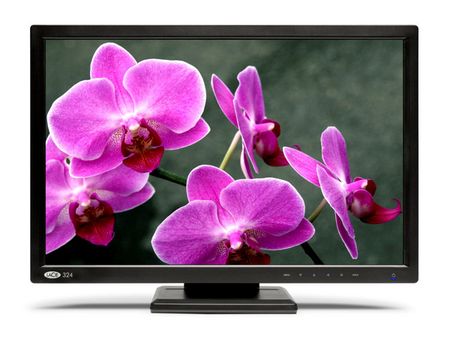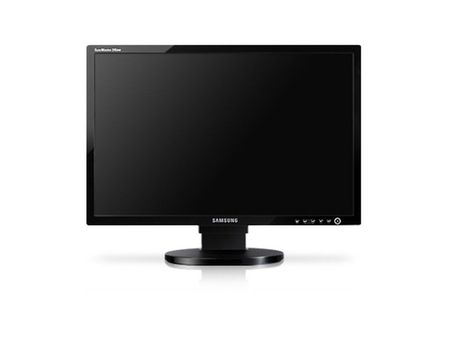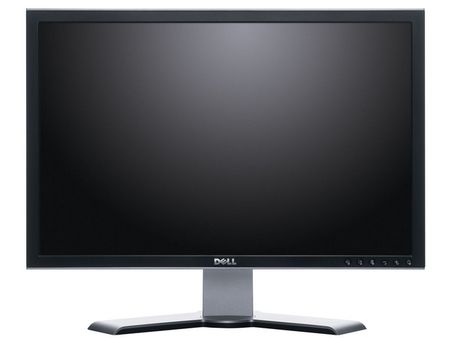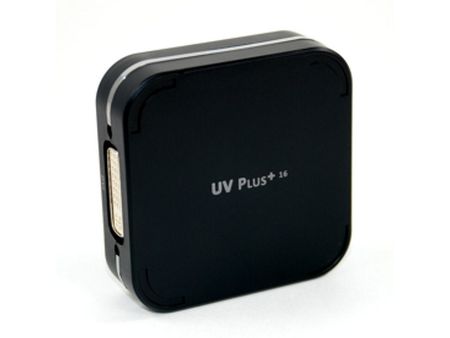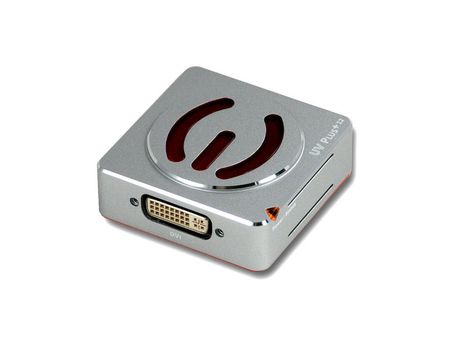Tom's Back To School Guide: Gear for Work
Displays
By Ed Tittel
LaCie 324 24” LCD Monitor with Hood and Calibration Software
$1,240, available from PCConnection.com
When it comes to flat panel displays for PCs, some are better than others, and they usually sport price tags to match. The main reasons for the high cost of high-end displays are their ability to reproduce color accurately, and also their overall resolution. More expensive monitors lend themselves well to photo editing, series computer graphics work, high-resolution animation and other graphics intensive applications. The best such monitors cost $3,000 or more, but this 24” LaCie monitor offers excellent color handling, 1920x1200 resolution, and even includes color calibration software, all for the relative bargain price of around $1,100.
Students learning about computer graphics, graphic arts, photography and so forth will find the LaCie 324 eminently well-suited to support their studies and related graphical interests. The unit also supports 10-bit gamma correction, offers two HDMI ports plus DVI-D and conventional VGA inputs, and even supports Faroudja Directional Correlation Deinterlacing (DCDi), to smoothe out the processing of rapidly moving images on-screen, which are common in action movies, sporting events and computer games. It even offers a snazzy picture-in-picture (PIP) capability, that permits easy repositioning of the PIP frame, and makes source selections for the main and PIP image feeds easy.
The calibration software included on CD-ROM with the unit permits users to select specific color profiles to drive the display, and to save their own custom profiles as needed.
Display options include four zoom and aspect ratio modes, including Dx2D, which magnifies the source to 1920x1200 resolution. You’ll also find accessible controls for brightness, contrast, color temperature, gamma, noise reduction and so forth. Overall, this monitor is a great tool for your graphically inclined student!
For more info, see the LaCie 324 product page
Samsung 245BW SyncMaster 24" Monitor
About $430, available from CDW.com
For those who don’t need serious graphics capability or color accuracy, the Samsung SyncMaster 245BW makes a great and affordable widescreen desktop monitor. At a price of around $400, it’s one of the cheapest 24" LCDs available. Despite the low cost, though, the 245BW offers 1920x1200 resolution, excellent brightness (400 cd/m2), a high contrast ratio (1000:1, 3000:1 dynamic), and excellent response time (5 ms). With HDCP support, even though this monitor lacks an HDMI port, it can still play back Blu-ray discs given the proper hook-ups using DVI-D or an HDMI to DVI-D adapter or cable. Its speedy response time also makes this monitor excel at computer gaming.
Samsung manages to keep the price down by skipping many of the features commonly found on 24" monitors. There are no USB ports, memory card readers, built-in loudspeakers or other frills (though some may argue that omitting HDMI is going too far). That said, unlike the LaCie 324, the 245BW offers less color capability and accuracy, by approximating 16.7 million colors rather than offering them directly and discretely. Also, this unit is best viewed straight on, as it offers a modest 160° viewing angle. But for typical Windows use, serious gaming, and light-duty graphics, students will find that the 245BW offers them a fabulous amount of screen real estate at a great price.
For those seeking to watch videos, play games, or run standard Windows applications on the big screen, the Samsung 245BW offers an excellent compromise between cost and capability. For more information on this monitor, please consult the Samsung product page .
Dell Ultrasharp 2408WFP Widescreen Flat Panel Monitor
$679, available from Dell.com
The Dell Ultrasharp LCD monitor family is nearly 10 years old; the latest model numbers end with an 08 suffix. We wanted to include the 27" model here, but it won’t be available until later this year, so we can’t share pictures or stats on it yet. The 2408 model is a smaller but still capable monitor that shares most of the same features its bigger cousin will also sport. Both units feature a resolution of 1920x1200, response time at 6 ms, color support at 16.7 million colors and 110% color gamut, with a 1300:1 contrast ratio.
What makes the 08 Ultrasharps interesting is their inclusion of Dell-driven VESA standard DisplayPort technology. Though it hasn’t been universally adopted by monitor makers, its royalty-free, license-free, digital audio and video interconnect capability seeks to give license- and royalty-required HDMI technology a run for consumer loyalty, if not for as much of their money. (For more information about DisplayPort, see the VESA press release .) Dell, however, hedges its bets on the 08 series by including both HDMI and DisplayPort hook-ups, as well as DVI-D, VGA, component video, S-Video, and composite video inputs.
The 2408WFP excels at gaming and at DVD playback, including Blu-ray content. It’s also great for conventional display activities from the Windows desktop. At just over $600, it costs half again as much as the SyncMaster 245BW, but its bells and whistles, plus ports and connectors galore, mean there’s ample added value to offset extra costs. Particularly for entertainment oriented students, the 2408WFP delivers an excellent combination of features and functions.
For more info on this display, please consult the Dell product page .
eVGA UV Plus+ USB VGA Display Port
$65-$80, available from CompUSA.com
The eVGA UV Plus+ is a USB device that offers support for an additional display on a notebook or desktop PC. Simply plug the UV Plus+ into an available USB port, attach a display, and you can extend your Windows desktop from your current monitor onto that display as well. Essentially, the UV Plus+ adds another graphics adapter to your PC via USB, thereby extending your desktop real estate without loading down your existing graphics circuitry.
The UV Plus+ comes in two models: the UV-16, which supports display resolutions of up to 1680x1200, and the UV-12, which supports display resolutions up to 1440x900. The UV-16 costs about $80 while the UV-12 goes for around $65. Either device offers a peachy way to extend your desktop, particularly for notebook PCs where simply plugging in an external monitor may either blank out the built-in display, or put too much strain on the built-in graphics processor. Both models work with Vista’s Aero mode, support 16.7 million colors, and include a DVI port with a VGA-to-DVI adapter for VGA-only monitors.
The device draws less than 500 mA at 5V, so it may be safely powered through the USB port even on a notebook PC. Reduced battery life shouldn’t be much of an issue, especially given that the external monitor needs a wall socket anyway! eVGA claims you can add as many as six UV Plus+ devices to a single PC, for up to 7 monitors in all. Needless to say, even at 480 Mbps, this could bog down a USB root hub pretty well!
For more information on the UV-16, see its product page , likewise for the UV-12.
Current page: Displays
Prev Page Functional, Fashionable Laptop Bags Next Page Headphones, Earphones and EarbudsGet Tom's Hardware's best news and in-depth reviews, straight to your inbox.
-
njalterio Haha.....as a university student who will be heading back to school for my final year this August I must say so much of this is unnecessary.Reply
First off, if you are living at home and/or still in high school absolutely none of this is necessary. Use the home PC.
Second, If you are going away to college, then get either a cheap laptop or desktop and one ethernet cable. End of story. You will be able to print through your university's printers, and most likely you will be able to get very cheap software from the university. I can buy Vista Ultimate for $15. Norton Antivirus is free.
Third, do not buy Apple as it is way to expensive. As a college student your money would be much better used elsewhere. This article did not do justice to Lenovo at all. I highly recommend a ThinkPad T61. (I priced a 2.4 GHz dual core and 4 GB of RAM and 100 GB hard drive for around $1100). The same hardware configuration would cost over $3000 in a Mac.
4) DO NOT SPEND MONEY IN WARRANTY/REPAIR/TROUBLESHOOTING SOFTWARE OR SERVICES! At your university there will be many smart and intelligent people who will be able to help you out for free. Depending on the size of your university, there will probably be a free tech support service somewhere on campus.
-
What about those of students who are in engineering and need laptops that can handle lots of CAD, a simple budget laptop will not do. Look at Mississippi State's requirements in the engineering dept for entering freshman, a required 256 bit gpu and they recommend 512 bit. Just wondering if we could see something more high end for the technical fields, this is a great read thoughReply
-
njalterio I am also a student in engineering and I am quite familiar with the computer hardware required. If you are an engineering major, then you should invest $200 more to get a laptop or desktop with discrete graphics.Reply
I was pointing out that a getting a $3000 laptop is ridiculous, and definitely should not be considered "vital" for back to school. -
mitch074 Overall quite nice, but:Reply
- getting a Thinkpad may be more expensive, but it has two enormous advantages: it's extremely sturdy, and it is easily serviceable; if you want to keep your laptop for 3 years, you'll have a better time with it than any other laptop series
- Google Docs is nice, but it requires an always-on Internet connection. I can't, for the life of me, understand why there's no OpenOffice.org mentioned anywhere: it's free, it's powerful, it's stable, and it's available for all systems cited (yes, even MacOS X - Aqua version will be out in september).
- if all you do is type notes and browse the Web, a netbook may just be what you need: lighter, smaller, cuter, faster to boot. It is also far less expensive. The MSI Wind and it's rather large screen and keyboard are a good thing, you can still get an USB keyboard and connect it to a flat screen TV to turn it into a more comfortable workstation in your dorm room.
For those of you telling me that 'Vista is required', bull: the Apple one runs OS X, you can run Linux or XP without trouble in such a context (yes, there is Java and Flash support under Linux; even Google Earth runs very well). -
gaiden I hope you chain that 24" LCD to an iron desk in your drom room. Best things for college are FREE or Second hand, no need to pay premium $$$ for new stuffs. I pay for my own tuition and all my other expense, so there is no way a 'regular' student or their parent will consider buying something this big and pricy. PC component side are decent however.Reply
The dude above who asks for a Laptop/notebook to work on CAD, maybe a Dell Vostro 1500 and possibly runs in XP. CAD doesn't have all the support from Vista yet...i don't think. Basically if you are all work and no play just make sure you get a Core 2 Duo CPU with a Quadro card and 3-4gb of RAM. If you play some games get a C2D/3-4gb RAM and a Nvidia 8600 and up instead of a Quadro
gl -
cangelini gaidenI hope you chain that 24" LCD to an iron desk in your drom room. Best things for college are FREE or Second hand, no need to pay premium $$$ for new stuffs. I pay for my own tuition and all my other expense, so there is no way a 'regular' student or their parent will consider buying something this big and pricy. PC component side are decent however. The dude above who asks for a Laptop/notebook to work on CAD, maybe a Dell Vostro 1500 and possibly runs in XP. CAD doesn't have all the support from Vista yet...i don't think. Basically if you are all work and no play just make sure you get a Core 2 Duo CPU with a Quadro card and 3-4gb of RAM. If you play some games get a C2D/3-4gb RAM and a Nvidia 8600 and up instead of a QuadroglReply
Ain't it the truth. Nothing tweaked me more than when I had an old-school HP notebook nabbed from my office on-campus during a two minute bathroom break. A shame you have to lock everything down just to let it out of your sight for a second.
-
In my opinion, if you don't play or make games, do scripting or anything else that may take lots of processing power you dont need to spend more than like... 300$ on a computer. To cut down on the price I would get 1gb 667 mhz (15$) of RAM, a Pentium Dual-Core (about 60$) and a PCI video card for about 50$. It would no doubt be more than enough for surfing the internet, watching movies, and using MS Word.Reply
-
mbmcavoy For students in a technical field, (engineering, computer science, etc), a Windows laptop probably is best due to specialty software/hardware needs. But for the majority of students in non-technical fields, I'd highly recommend the MacBook.Reply
Sure it seems more expensive if you compare hardware spec sheets, but the OS and included Apps make it a worthwhile package. Plus, iWork is much cheaper than MS Office. (Oh, and currently a free $300 iPod Touch for students and teachers sweetens the pot!)
General setup and maintenance issues are much less, so you'll have more time for actual studying - especially important for the non-techie! And while Windows has "sleep" features, I've never had consistent success with it. The sleep on my MacBook is bulletproof, and it wakes up in about 1 second. Perfect for the mad dash between classes!
Of course, if you are a non-techie, you probably aren't reading THG... :)
